In the ever-evolving landscape of digital marketing, email remains a cornerstone for effective communication and engagement. However, with inboxes inundated with countless messages, standing out requires more than just compelling content—it demands personalization and relevance. Enter dynamic emails, a transformative approach that tailors content in real-time based on individual user data and behaviors. This comprehensive guide delves into the essence of dynamic emails, exploring innovative strategies, best practices, and how tools like Prism Reach can elevate your email marketing campaigns to new heights.
Key Facts About Dynamic Emails
- Personalization: Tailors content to individual preferences and behaviors, enhancing relevance.
- Real-Time Updates: Ensures recipients always see the most current and pertinent information.
- Interactive Elements: Incorporates features like polls, forms, and live feeds to boost engagement.
- Higher Engagement Rates: Personalized and interactive content leads to increased open and click-through rates.
- Improved Conversion Rates: Relevant offers and recommendations drive more sales and conversions.
Upgrade Your Email Marketing with AI Personalization!
Understanding Dynamic Emails
Dynamic emails represent an advanced form of email marketing that adapts content in real-time based on various data points, such as user behavior, preferences, and external factors. Unlike traditional static emails, which deliver the same content to every recipient, dynamic emails create a personalized experience for each subscriber, significantly enhancing engagement and effectiveness.
How Dynamic Emails Differ from Traditional Emails
- Content Adaptability: Dynamic emails adjust content post-sending, while static emails remain unchanged.
- Personalization Level: Dynamic emails offer a higher degree of personalization, including personalized greetings, product recommendations, and content blocks tailored to individual interests.
- Interactivity: Dynamic emails often include interactive elements such as forms, polls, and real-time updates, enhancing user engagement.
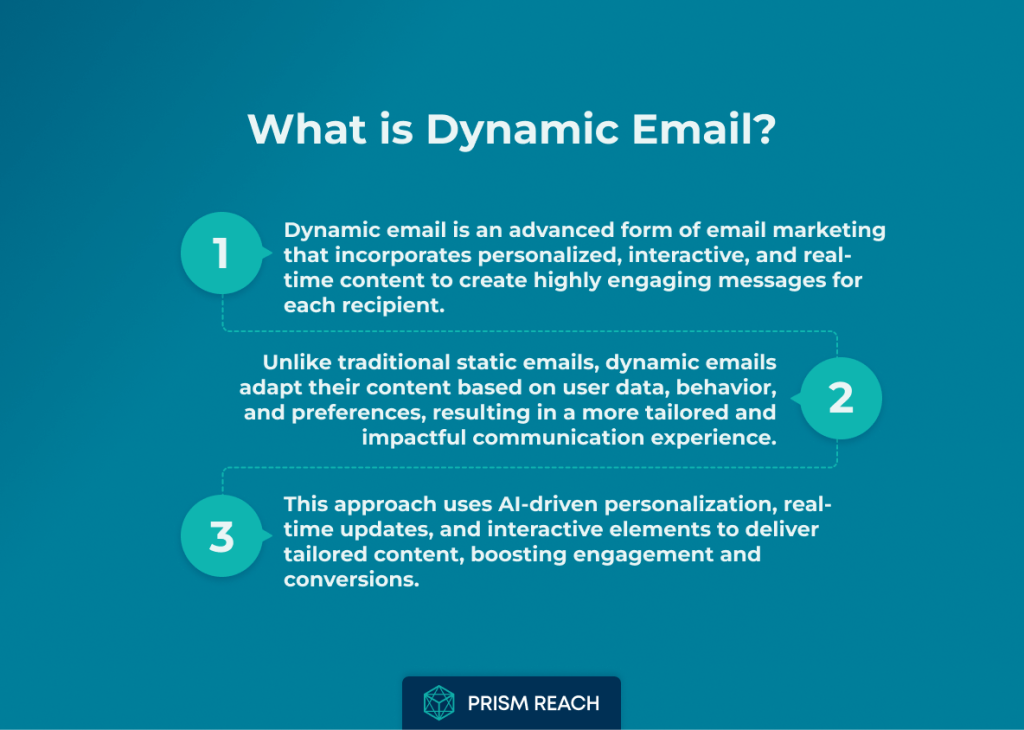
Hidden Gems Strategies for Dynamic Email
To fully harness the power of dynamic emails, consider integrating these lesser-known but highly effective strategies into your campaigns:
1. Micro-Segmentation Layering
Instead of relying on broad audience segments, implement multiple layers of micro-segmentation. By combining ultra-specific data points like purchase history, browsing behavior, and engagement patterns, you can create hyper-personalized content blocks that resonate deeply with each recipient.
2. Sentiment-Based Dynamic Content
Leverage natural language processing to analyze the sentiment behind customer interactions, such as support tickets and reviews. Adjust your email content dynamically to match the recipient’s emotional state, whether that’s offering empathy, celebration, or tailored solutions, thereby fostering a stronger emotional connection.
3. Progressive Profiling Through Interactive Elements
Incorporate interactive elements like quizzes or preference selectors within your emails. Use the responses to progressively build detailed user profiles, enabling more informed and effective personalization in future communications.
4. AI-Powered Content Generation
Utilize artificial intelligence to generate multiple versions of email copy. Employ dynamic content blocks to A/B test these variations in real-time, automatically selecting the best-performing version for each recipient, thereby optimizing engagement and effectiveness.
5. Contextual Imagery Adaptation
Implement systems that dynamically change email imagery based on real-time factors such as local weather conditions, current events, or cultural celebrations in the recipient’s location. This contextual relevance enhances the visual appeal and connection of your emails.
Best Practices for Creating Dynamic Emails
Implementing dynamic emails effectively requires careful planning and execution. Here are some best practices to ensure your dynamic email campaigns are successful:
1. Start with Clean, Accurate Data
- Data Hygiene: Ensure your customer data is up-to-date and well-organized. Regularly clean your database to remove inactive or invalid email addresses, reducing bounce rates and improving deliverability.
- Reliable Data Sources: Use trustworthy data sources to maintain accuracy in personalization efforts. Integrate data from multiple touchpoints, such as purchase history, website interactions, and social media engagements, to create a comprehensive view of each subscriber.
- Data Enrichment: Enhance your data with additional information like demographic details, preferences, and behaviors. Tools like Prism Reach can help automate data enrichment, ensuring your personalization is based on the most relevant and current information.
2. Segment Your Audience
- Behavioral Segmentation: Create meaningful segments based on user behavior, such as purchase frequency, browsing history, and engagement levels. This allows you to target users with content that aligns with their specific actions and interests.
- Preferences and Demographics: Segment your audience by preferences, demographics, and other relevant criteria. Use micro-segmentation layering to target ultra-specific groups, enhancing the precision of your campaigns.
- Continuous Refinement: Continuously refine your segments based on ongoing data analysis and user feedback. Regularly update your segments to reflect changes in user behavior and preferences, ensuring your dynamic content remains relevant.
3. Use a Mix of Static and Dynamic Content
- Balanced Personalization: Not everything needs to be personalized; find the right balance between static and dynamic content. Use static content for universal messages and dynamic content for personalized elements like recommendations and offers.
- Message Consistency: Ensure that static content complements the dynamic elements to maintain overall message consistency. Consistent messaging reinforces your brand and ensures that dynamic content seamlessly integrates with the broader email narrative.
- Highlight Key Personalizations: Use dynamic content for key personalized elements such as product recommendations, personalized offers, and relevant content blocks. This targeted approach enhances the impact of your email campaigns.
4. Incorporate Interactive Elements
- Engagement Boosters: Include interactive elements like polls, surveys, and quizzes to engage recipients and gather more data. These elements make your emails more engaging and provide valuable insights into user preferences.
- Valuable Insights: Use interactive elements to drive user engagement and provide valuable insights. For example, quizzes can help you understand subscriber interests, while polls can gauge customer satisfaction.
- Mobile-Friendly Design: Ensure that interactive elements are mobile-friendly and easy to use. With a significant portion of emails being read on mobile devices, it’s crucial that your interactive features function seamlessly across all platforms.
5. Leverage AI for Content Generation and Optimization
- AI-Powered Tools: Use AI-powered tools like Prism Reach to generate and test multiple versions of email content. AI can help create personalized subject lines, content variations, and optimized layouts based on user data.
- Continuous Optimization: Continuously optimize your content based on performance data and AI insights. AI algorithms can analyze engagement metrics to suggest improvements and automatically adjust content for better performance.
- Automated A/B Testing: Automate A/B testing to determine the best-performing content variations. AI can handle the testing process in real-time, ensuring that the most effective content is delivered to each recipient without manual intervention.
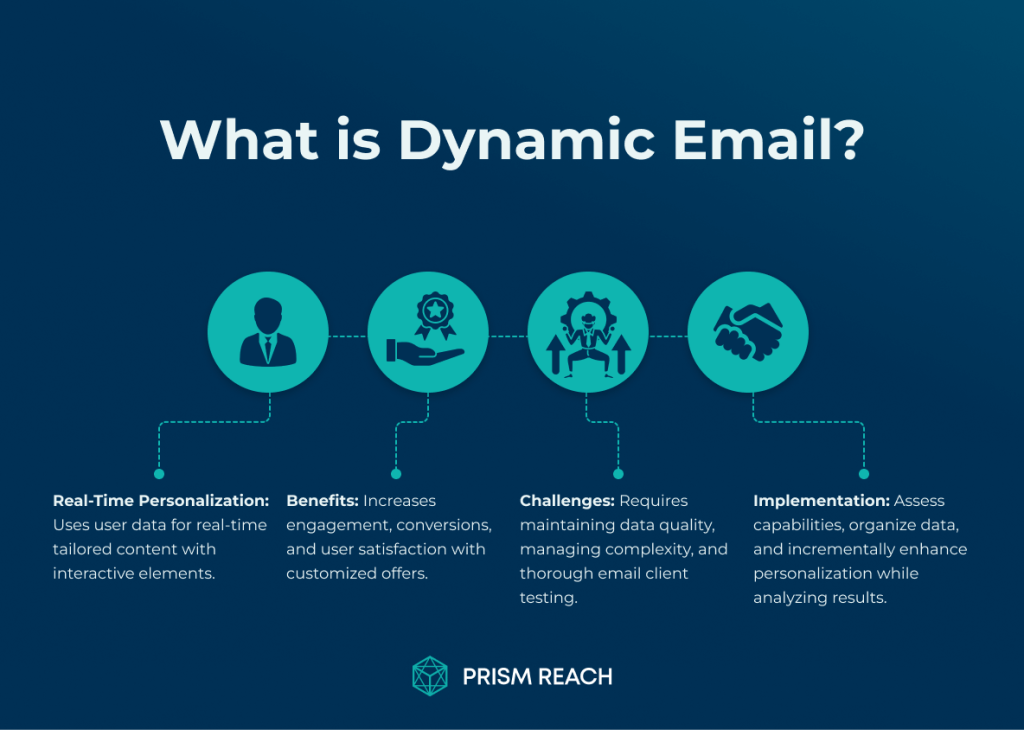
Benefits of Using Dynamic Emails
Dynamic emails offer a plethora of advantages over traditional static emails, making them a valuable asset in any email marketing strategy:
1. Higher Engagement Rates
- Personalized Content: Personalized and interactive content resonates more with recipients, leading to higher open and click-through rates.
- Relevant Messaging: By delivering content that aligns with individual interests and behaviors, dynamic emails capture the recipient’s attention more effectively.
- Interactive Features: Elements like polls, surveys, and quizzes increase engagement by encouraging recipients to interact with the email content actively.
2. Improved Conversion Rates
- Targeted Offers: Relevant offers and tailored recommendations drive more sales and conversions by addressing the specific needs and preferences of each recipient.
- Timely Promotions: Real-time updates and time-zone optimized offers ensure that promotions are always relevant and create a sense of urgency, encouraging quicker decision-making.
- Enhanced User Experience: A seamless and personalized user experience increases the likelihood of conversion by making the purchasing process more intuitive and aligned with user expectations.
3. Enhanced User Experience
- Interactive Elements: Interactive elements and real-time updates make emails more enjoyable and useful for recipients, enhancing their overall experience.
- Personal Relevance: Content that is tailored to individual preferences and behaviors ensures that users find the information relevant and valuable.
- Consistent Messaging: A balanced mix of static and dynamic content maintains message consistency while providing personalized touches, resulting in a cohesive and pleasant user experience.
4. Better Data Collection
- Insightful Interactions: Interactive elements provide valuable insights into user preferences and behaviors, helping you refine your marketing strategies.
- Behavioral Data: Collecting data from user interactions within emails, such as poll responses and quiz answers, enhances your understanding of your audience.
- Continuous Improvement: The data collected from dynamic emails allows for continuous improvement of your campaigns, ensuring that they remain effective and relevant over time.
5. Increased Email Relevance
- Real-Time Updates: Real-time updates ensure that content is always current and pertinent to the recipient’s needs, making your emails more relevant and timely.
- Contextual Personalization: By adapting content based on factors like location, weather, and local events, dynamic emails deliver highly relevant information that resonates with recipients.
- Predictive Content: Machine learning algorithms predict future user behavior and adjust email content accordingly, ensuring that your messaging aligns with anticipated needs and interests.
Three Benefits of Prism Reach for Dynamic Email Marketing
- AI-Powered Personalization: Prism Reach leverages sophisticated AI algorithms to customize every aspect of newsletters based on subscriber behavior and preferences, enhancing content relevance.
- Seamless Setup and Integration: With a quick setup process and one-click uploads, Prism Reach allows for easy migration of existing subscriber lists, streamlining the implementation of dynamic email strategies.
- Dynamic Content Selection: The platform’s AI determines the most relevant content for each subscriber, ensuring that every newsletter is highly personalized and engaging.
How Prism Reach Enhances Dynamic Email Marketing
Prism Reach is an innovative AI-powered SaaS solution designed to elevate your email marketing campaigns through deep personalization. Here’s how Prism Reach stands out:
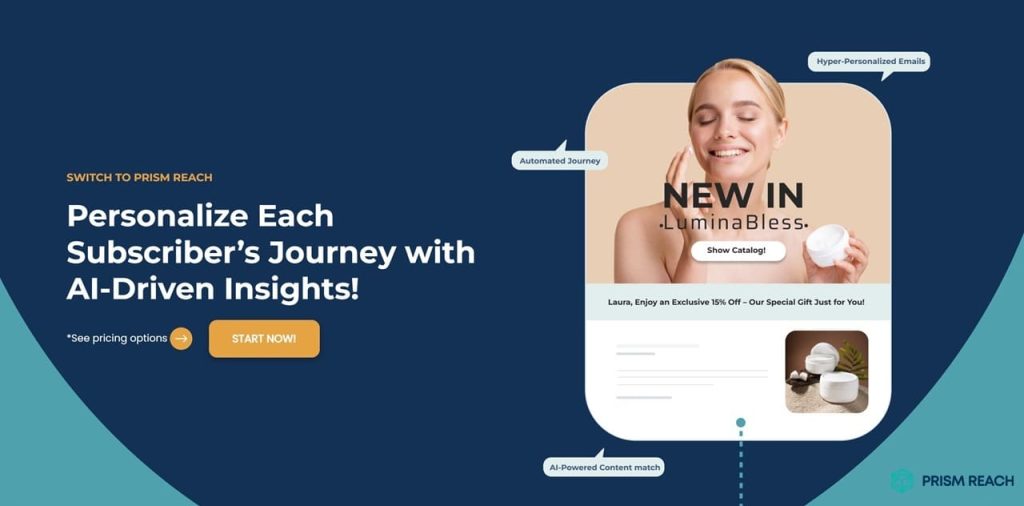
AI-Powered Personalization
Prism Reach’s core functionality revolves around its proprietary AI technology, which clusters website content and social media posts into relevant categories. This AI utilizes a variety of data points to create detailed user avatars, enabling personalized newsletter content that incorporates factors such as location, engagement history, and predicted interests.
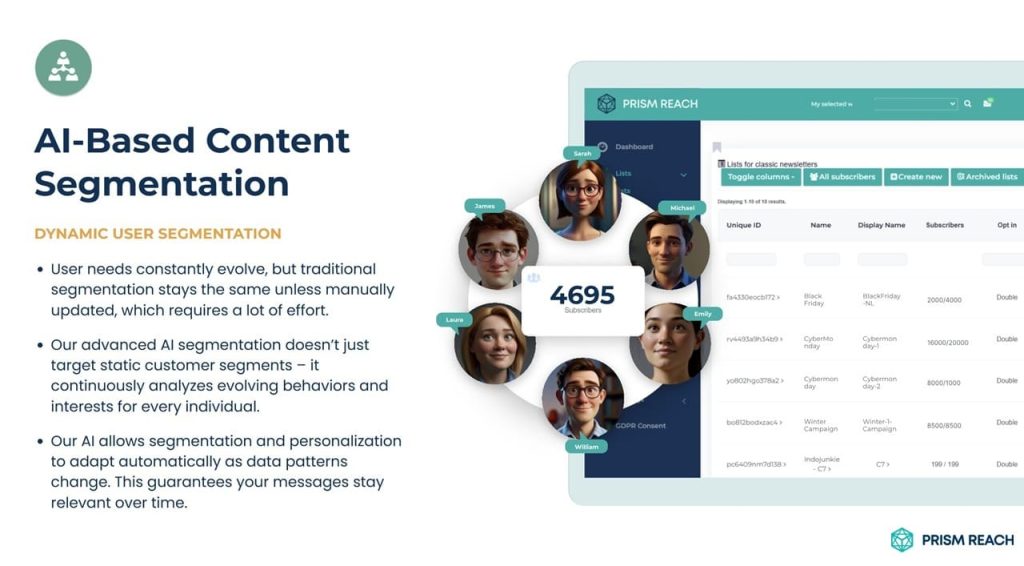
Seamless Setup and Integration
The platform can be integrated within 10 minutes, making it user-friendly for publishers of all sizes. One-click uploads facilitate easy migration of existing subscriber lists, and AI-enhanced sign-up forms are designed to increase sign-up rates through AI-generated content tailored to the user’s context while improving GDPR compliance.
Dynamic Content Selection
Prism Reach’s AI determines the most relevant content for each subscriber, enhancing the personalization of each newsletter. Whether it’s trending articles or product suggestions, the content blocks are tailored to match each recipient’s unique preferences.
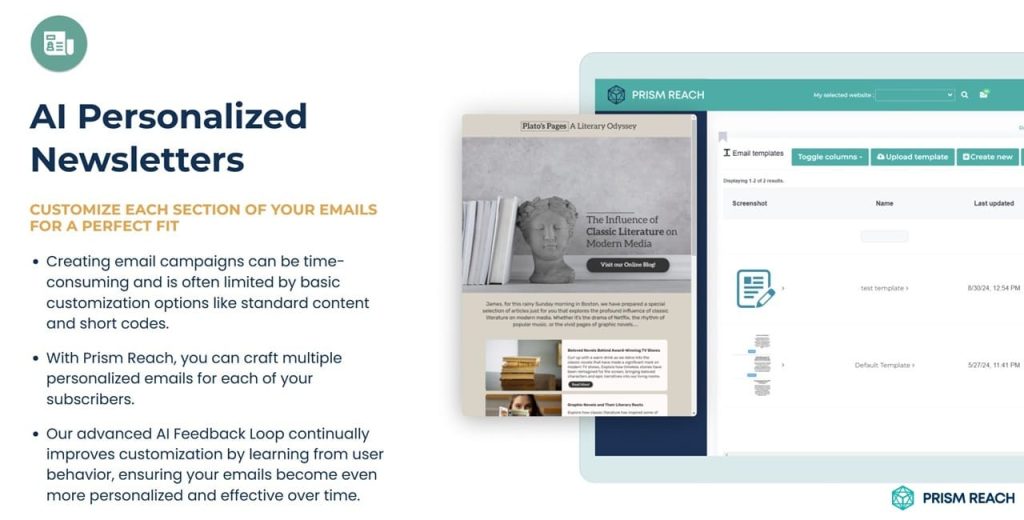
Best Practices for Creating Dynamic Emails
Implementing dynamic emails effectively requires careful planning and execution. Here are some best practices to ensure your dynamic email campaigns are successful:
1. Start with Clean, Accurate Data
- Data Hygiene: Ensure your customer data is up-to-date and well-organized. Regularly clean your database to remove inactive or invalid email addresses, reducing bounce rates and improving deliverability.
- Reliable Data Sources: Use trustworthy data sources to maintain accuracy in personalization efforts. Integrate data from multiple touchpoints, such as purchase history, website interactions, and social media engagements, to create a comprehensive view of each subscriber.
- Data Enrichment: Enhance your data with additional information like demographic details, preferences, and behaviors. Tools like Prism Reach can help automate data enrichment, ensuring your personalization is based on the most relevant and current information.
2. Segment Your Audience
- Behavioral Segmentation: Create meaningful segments based on user behavior, such as purchase frequency, browsing history, and engagement levels. This allows you to target users with content that aligns with their specific actions and interests.
- Preferences and Demographics: Segment your audience by preferences, demographics, and other relevant criteria. Use micro-segmentation layering to target ultra-specific groups, enhancing the precision of your campaigns.
- Continuous Refinement: Continuously refine your segments based on ongoing data analysis and user feedback. Regularly update your segments to reflect changes in user behavior and preferences, ensuring your dynamic content remains relevant.
3. Use a Mix of Static and Dynamic Content
- Balanced Personalization: Not everything needs to be personalized; find the right balance between static and dynamic content. Use static content for universal messages and dynamic content for personalized elements like recommendations and offers.
- Message Consistency: Ensure that static content complements the dynamic elements to maintain overall message consistency. Consistent messaging reinforces your brand and ensures that dynamic content seamlessly integrates with the broader email narrative.
- Highlight Key Personalizations: Use dynamic content for key personalized elements such as product recommendations, personalized offers, and relevant content blocks. This targeted approach enhances the impact of your email campaigns.
4. Incorporate Interactive Elements
- Engagement Boosters: Include interactive elements like polls, surveys, and quizzes to engage recipients and gather more data. These elements make your emails more engaging and provide valuable insights into user preferences.
- Valuable Insights: Use interactive elements to drive user engagement and provide valuable insights. For example, quizzes can help you understand subscriber interests, while polls can gauge customer satisfaction.
- Mobile-Friendly Design: Ensure that interactive elements are mobile-friendly and easy to use. With a significant portion of emails being read on mobile devices, it’s crucial that your interactive features function seamlessly across all platforms.
5. Leverage AI for Content Generation and Optimization
- AI-Powered Tools: Use AI-powered tools like Prism Reach to generate and test multiple versions of email content. AI can help create personalized subject lines, content variations, and optimized layouts based on user data.
- Continuous Optimization: Continuously optimize your content based on performance data and AI insights. AI algorithms can analyze engagement metrics to suggest improvements and automatically adjust content for better performance.
- Automated A/B Testing: Automate A/B testing to determine the best-performing content variations. AI can handle the testing process in real-time, ensuring that the most effective content is delivered to each recipient without manual intervention.
Common Challenges and How to Overcome Them
While dynamic emails offer significant benefits, they also come with their own set of challenges. Here’s how to address some of the most common obstacles:
1. Ensuring Compatibility Across Email Clients
Different email clients may render dynamic content differently. To ensure a consistent experience:
- Test your emails across various platforms and devices.
- Use responsive design principles to ensure content adapts to different screen sizes.
- Implement fallback options in case dynamic elements fail to load properly.
2. Managing Data Accuracy and Timeliness
Effective personalization relies on accurate and up-to-date user data. To maintain data quality:
- Implement regular data cleansing processes.
- Use real-time data synchronization to keep information current.
- Integrate data sources to provide a comprehensive view of user behavior.
3. Balancing Personalization with Privacy Concerns
While personalization is key to dynamic emails, it’s important to respect user privacy:
- Be transparent about how you use subscriber data.
- Ensure compliance with data protection regulations like GDPR.
- Provide options for users to manage their preferences and data usage.
Getting Started with Dynamic Emails
Implementing dynamic emails can seem daunting, but with the right tools and strategies, it becomes manageable. Here’s a step-by-step guide to help you get started:
1. Assess Your Current Email Marketing Platform’s Capabilities
Determine if your existing platform supports dynamic content. If not, consider upgrading or switching to a solution like Prism Reach that offers advanced dynamic email features.
2. Collect and Organize Your Customer Data
Gather data from various sources, including purchase history, website interactions, and social media engagement. Organize this data to facilitate effective segmentation and personalization.
3. Identify Key Segments Within Your Audience
Create segments based on demographics, behavior, and preferences. Utilize micro-segmentation layering for more precise targeting.
4. Start with Simple Personalization
Begin with basic personalization techniques, such as addressing recipients by name and including location-specific content. Gradually incorporate more complex dynamic elements as you become more comfortable.
5. Test Different Dynamic Elements
Experiment with various dynamic features, such as interactive polls, real-time updates, and personalized product recommendations. Use A/B testing to determine what resonates best with your audience.
6. Continuously Analyze Results and Refine Your Approach
Regularly review campaign performance metrics to assess the effectiveness of your dynamic email strategies. Use insights to make data-driven adjustments and optimize future campaigns.
FAQ
Conclusion: Embracing the Dynamic Email Revolution
Dynamic emails represent a significant evolution in email marketing, offering unprecedented levels of personalization and engagement. By leveraging real-time data and interactive elements, marketers can create highly relevant and impactful communications that resonate with individual subscribers on a deeper level. While implementing dynamic emails may seem complex, tools like Prism Reach simplify the process, making it accessible for businesses of all sizes.
As AI and machine learning technologies continue to advance, the potential for dynamic emails will only grow. Embracing these innovations today can position your email marketing strategy for success in the future. Start small, test thoroughly, and continuously refine your approach to unlock the full potential of dynamic emails and take your email marketing to new heights.
Sources
- Campaign Monitor Blog: How to Use Dynamic Content to Increase Email Engagement
- Funnel.io: Beyond ‘Dear Name’ – Email Personalization Techniques
- Holistic Email Marketing: 6 Sophisticated Examples of Dynamic Content Emails in 2017
- SalesHandy: Email Personalization Tools
- NoGood: Dynamic Email Content (June 2024)